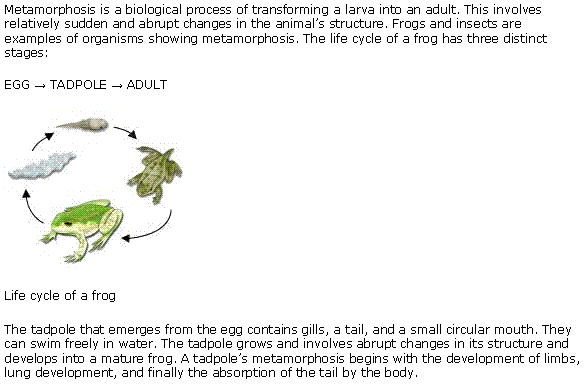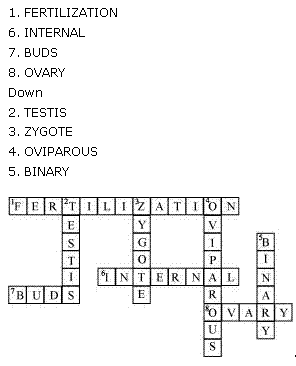Class 8 NCERT Solutions Science Chapter 6 - Reproduction in Animals
Reproduction in Animals Exercise 76
Solution 1
Reproduction is a biological process through which living organisms produce offspring similar to themselves. Living organisms reproduce to maintain their number and continuation of their species.
Concept insight: Reproduction ensures the continuation of similar kinds of individuals.
Solution 2
Fertilization involves the fusion of the male and the female gametes. The male and the female gametes are released from the male and the female reproductive organs. Sperms or male gametes are released from the male reproductive organ i.e., the penis. These sperms then enter the female body through the vagina. Then, they travel through the fallopian tubes where they fuse with eggs. Hence, the process of fertilization takes place in the fallopian tubes.
Concept insight: Fertilization is the process of fusion of male and female gametes in the fallopian tube of the females.
Solution 3
(a) (i) Internal fertilization occurs in the female body.
(b) (ii) A tadpole develops into an adult frog by the process of metamorphosis.
(c) (ii) The number of nuclei present in a zygote is one.
Concept insight: Important from Exam Point of View.
Solution 4
(a) Oviparous animals give birth to young ones. - False
Concept insight: Oviparous organisms lay eggs.
(b) Each sperm is a single cell. - True
Concept insight: Gametes are single celled.
(c) External fertilization takes place in frogs. - True
Concept insight: Fertilization which takes place outside the body of the female is called external fertilization.
(d) A new human individual develops from a cell called gamete. - False
Concept insight: Gametes are haploid cells which fuse together to form zygote and gives rise to a new human being.
(e) Egg laid after fertilization is made up of a single cell. - True
Concept insight: Fertilized egg is a single cell.
(f) Amoeba reproduces by budding. - False
Concept insight: Amoeba reproduces by binary fission.
(g) Fertilization is necessary even in asexual reproduction. - False
Concept insight: In asexual reproduction, only one parent is required so fusion of gametes does not takes place:
(h) Binary fission is a method of asexual reproduction. - True
Concept insight: Since a single organism is involved in binary fission to form two individuals so it is a method of asexual reproduction.
(i) A zygote is formed as a result of fertilization. - True
Concept insight: Fertilization is the process in which male and female gametes fuse together to form a zygote.
(j) An embryo is made up of a single cell. False
Concept insight: Embryo is multicellular as it is formed from zygote after repeated divisions. And it shows all the main recognizable body parts.
Solution 5
|
Zygote |
Foetus |
|
(i) It is fertilized egg formed after the fusion of the sperm with the egg. |
(i) It is a stage of the embryo that shows all the main recognizable body parts of a mature organism. |
|
(ii) The zygote divides several times to form an embryo. |
(ii) An embryo gradually develops into a foetus. |
Concept insight: List the changes in the development of an offspring from zygote to a foetus.
Solution 6
Asexual reproduction is a mode of reproduction that does not involve tile fusion of the male and the female gametes. It requires only one parent, and the offsprings produced are exact copies of their parents.
Two methods of asexual reproduction in animals are:
(i) Binary fission: It is a type of asexual reproduction in which a single cell divides into two halves, Organisms that reproduce through binary fission are bacteria and Amoeba. In Amoeba, the division of cells can take place in any plane. It involves the division of its nucleus into two nuclei, which is followed by the division of its body into two halves, Each half of the body receives a nucleus.
Fig: Binary fission in Amoeba
(ii) Budding: Budding involves the formation of a new individual from the bulges, known as buds formed on the parent body, This method of reproduction is common in Hydra, In Hydra, the cells divide rapidly at a specific site and develop as an outgrowth, called the bud. These buds, while being attached to the parent plant, develop into smaller individuals. When these individuals become mature enough, they detach from the parent's body and become independent individuals.
Fig: Budding in Yeast
Concept insight: Asexual reproduction involves only a single parent and fusion of gametes does not take place in this process.
Solution 7
The embryo gets embedded in the wall of the uterus. The embryo while it is still attached to the uterus gradually develops various body parts such as hands, legs, head, eyes, etc. The embryo is then called a foetus.
Concept insight: An embryo develops into a foetus.
Solution 8
Concept insight: The transformation of the larva into an adult through drastic changes is called metamorphosis.
Solution 9
|
Internal fertilization |
External fertilization |
|
i. It involves the fusion of the male and the female gamete inside the female body. |
i. It involves the fusion of the male and the female gamete outside the female body. |
|
ii. Chances of the survival of the offspring are more. Therefore, a small number of eggs are produced. |
ii. Chances of survival of the offspring are less. Therefore, a large number of eggs are produced. |
|
iii. Humans, cows, hens are organisms showing internal fertilization. |
iii. Fish, frog, starfish are organisms showing external fertilization. |
Concept insight: List the differences between internal and external fertilization.
Reproduction in Animals Exercise 77
Solution 10
Concept insight: Terms used are important from Exam Point of View.





